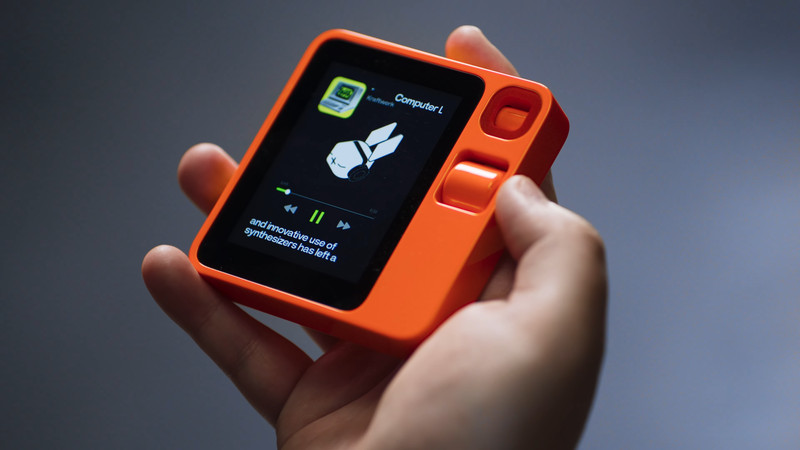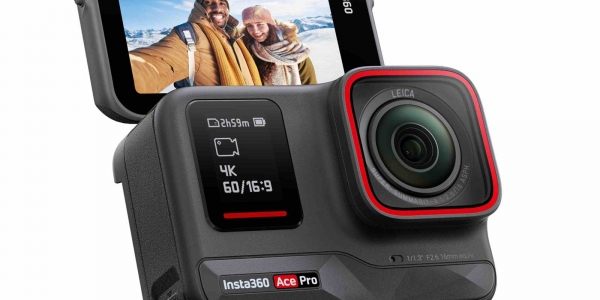Introducing the Rabbit R1, yet another AI in a box—a testament to our era. Bearing resemblance to the Humane Ai Pin in many ways, for better or worse, it boasts two distinct features, or so they claim. Let’s delve into it.
AI In A Box
Picture this: a virtual assistant packaged neatly in a non-wearable box. It’s compact, not much bigger than a stack of Post-its, crafted by the wizards at Teenage Engineering—currently the darlings of design enthusiasts. You can spot it from afar; its unique design sets it apart. With just one button on its side, you press and hold to engage. Unlike its counterparts, it houses a built-in screen instead of a projector and accommodates a SIM card tray beside the USB Type-C port for charging. While it heavily relies on the Cloud for processing requests, it responds noticeably faster than the Humane Ai Pin, albeit setting a low bar.
“How far away is the moon?”
[AI Voice] “The average distance between Earth and the Moon is approximately 384,400 kilometers.”
You can connect via Bluetooth for headphones or crank up the built-in speaker. The answer appears on the screen beneath a bouncing rabbit mascot, alongside the time and battery life—a constant presence indicating its wakefulness. To access settings, no buttons to press or gestures to perform; simply shake it like an Etch A Sketch. From there, navigate using a scroll wheel and select with a button—an unconventional UI approach.
Adding to its repertoire are a scroll wheel and a swiveling camera. The former, for navigating the UI sans screen, is a tad peculiar—I’ll explain why shortly. As expected, the AI assistant integrates vision for answering queries about its surroundings. To activate, double-tap to reveal the camera, then press and hold to inquire.
“I don’t know. What type of plant is this?”
[AI Voice] “Taking a look now. The plant in the image appears to be a Monstera deliciosa, also known as a Swiss cheese plant. This is a type of tropical climbing evergreen plant native to southern Mexico and parts of Central America. The large glossy green leaves with distinctive-“

As a reviewer, interacting with it feels akin to that DJ Khaled clip, endlessly pointing at objects, asking, “Okay, what is this? And what is this?”
“And what is this?”
[Speaker] “Those are pickled banana peppers.”
“And what is this?”
[Speaker] “Berries and seeds.”
“And perhaps what is this?”
[Speaker] “Water.”
“But I’ve also experimented with it differently. I’ve aimed it at my computer screen with a lengthy email displayed, and asked for a summary. It swiftly processes the text and provides me with a concise summary. It’s been quite impressive in handling articles too. I find that capability pretty cool. However, it’s essentially an AI confined within a box, excelling primarily at responding to queries.”
“It’s Also Flawed
(humming) (gentle melody)
On the downside, this device falls short in numerous aspects, echoing familiar complaints. Surprisingly, its battery life rivals that of the infamous Humane Pin. Despite housing a sizable battery, it performs abysmally, draining rapidly even when idle, barely lasting four hours. Recharging takes an agonizing 45 minutes from zero to full, exacerbating the inconvenience. Moreover, it lacks fundamental features like setting alarms, timers, capturing videos or photos, sending emails, or incorporating a built-in calendar—essentials one would expect from an assistant. Additionally, typical of AI assistants, it occasionally provides erroneous responses, leading to frequent instances of misinformation, a notable drawback of this category.”

“Designed by Teenage Engineering, the device embraces a distinct aesthetic, characterized by its vibrant orange hue, exuding a quirky and approachable vibe. However, its reliance on analog controls, particularly the protruding scroll wheel, proves cumbersome to use. The scroll wheel’s sensitivity is deliberately toned down to prevent accidental scrolling, resulting in sluggish navigation. Furthermore, the absence of haptic feedback exacerbates the challenge. Notably, the device lacks a dedicated back button, necessitating tedious scrolling to navigate back to previous menus. Adjusting brightness or volume requires a two-handed approach, adding to the inconvenience. While these quirks contribute to its unique user interface, many issues could be resolved with the incorporation of a touchscreen.”
“Interestingly, the device does feature a touchscreen, albeit severely underutilized. While it could streamline menu navigation and improve user experience, its functionality is restricted primarily to typing queries in terminal mode. While this feature allows for text-based interactions, it begs the question: why limit touchscreen functionality? Perhaps it’s a deliberate attempt to differentiate from smartphones, but the decision feels restrictive and counterintuitive.”
“The Purpose Behind the Box
So, what’s the rationale behind this device’s existence? How does it differentiate itself from its similarly flawed predecessor? The creators pin their hopes on two distinguishing factors, as articulated by co-founder Jesse…”
“But I doubt MKBHD would rank this as the worst device he’s ever reviewed. (laughter)”
“Alright, let’s break it down. There were two main gripes: the price and the touted ‘large action model’. The Humane Pin was an easy target due to its steep price tag – $700 plus a monthly subscription just to keep it functional? Absurd. In contrast, this alternative only sets you back $200 with no subscription, which feels a tad more reasonable. However, it’s evident where they’ve cut costs. Firstly, you’ll need a separate SIM card for cellular connectivity, adding to your monthly expenses. The unboxing experience is barebones, with just a cardboard box containing the device and a plastic container doubling as a stand. No frills like a charging brick or USB-C cable included.
The device itself? Plastic. It’s sturdy but lacks the premium feel. The camera and speaker are basic, housing a low-end MediaTek chip akin to budget smartphones. Don’t expect fancy features like fast or wireless charging either. Plus, it only comes in one eye-searingly bright orange color, though you can opt for a more subdued look with third-party skins.

Now, onto the touted ‘large action model’. Think of it as an AI assistant on steroids, designed to execute tasks based on your commands, much like a human would interact with apps. It’s an intriguing concept, but the execution falls short. While it can handle basic actions like playing Spotify songs or ordering food, it’s prone to errors and lacks support for many apps. Only four are currently functional, with promises of more to come, along with features like a ‘Teach Mode’ for custom tasks. However, these remain on the drawing board for now.
In summary, while the device offers a budget-friendly alternative, it’s clear corners have been cut. The ‘large action model’ shows promise but needs substantial improvement to justify its hype. For now, it’s a case of potential overshadowed by unfulfilled promises.”
“Let’s avoid turning this into a rant, but it’s worth acknowledging that many tech companies seem to be developing products in a somewhat backwards manner. They’re releasing such incomplete products that reviewing them becomes nearly impossible. It used to be simpler: create the product, then sell it. Now, it’s more like sell it first, then deliver a half-baked version, and gradually improve it through updates until it matches the initial promises. This interim period is chaotic, and it’s evident across various product categories.
Take gaming, for example. Major studios release games riddled with bugs, passing them off as alpha versions with promises of future updates. Yet, consumers are paying full price for what should be a polished AAA game. The trend extends to vehicles, too. Manufacturers announce features that are missing upon delivery, promising to add them later via software updates.
Smartphones have long followed this pattern, but it seems more pronounced now. Each launch boasts exciting features that won’t be available until later in the year. AI-based products epitomize this trend, where initial versions barely function compared to the promised capabilities. Yet, consumers pay full price upfront, which seems absurd.
This situation is frustrating for both consumers and reviewers. How do you evaluate a product when its future potential is fantastic, but its current state is subpar? Do you give them the benefit of the doubt? It’s a perplexing dilemma.
On one hand, it’s positive that tech products can improve over time. The idea of buying something that gets better with updates is appealing. However, the flip side is receiving incomplete products, and this trend may worsen before improving.”
“I’m genuinely enthusiastic about the concept of a highly personalized AI assistant that mirrors the capabilities of a human assistant. It’s a vision I deeply cherish. What fascinates me is the diverse approaches various companies are taking toward this goal. Achieving it, however, will demand substantial time, effort, technical advancements, and a wealth of data. As I’ve previously emphasized, a top-notch assistant, be it human or virtual, must possess comprehensive knowledge about you — your preferences, whereabouts, activities, and every nuanced detail. Gathering and processing such vast amounts of data is no small feat.
Regarding the Rabbit, their strategy seems centered on offering an exceptionally low price point. Convincing consumers to invest in a product that’s still in its developmental stages is challenging. With the Pin, for instance, you’re looking at a $700 upfront cost plus a $24 monthly fee, all in the hope that it will eventually deliver on its promises. On the contrary, the Rabbit, priced at $200, presents a far more palatable investment. It’s easier to take a chance on something affordable, especially considering its potential future enhancements. Perhaps some of its 800 apps will prove invaluable, or its Teach Mode might unlock functionalities beyond what we currently imagine.
This situation reminds me of Tesla’s early days, when they introduced autopilot features in their cars. Initially, Tesla gained popularity for its electric cars with impressive range and a robust charging infrastructure. As people began beta testing autopilot capabilities, Tesla amassed vast amounts of real-world data, which proved instrumental in refining their autopilot software. Similarly, I envision Rabbit leveraging its competitive pricing to saturate the market, allowing users to beta test and train the device across various tasks. However, Rabbit lacks the immediate appeal of its competitors, posing a classic chicken-and-egg dilemma.
My advice remains unchanged: assess a product based on its current merits rather than its potential future capabilities. If the Rabbit’s current features justify the $200 price tag for you, then by all means, go ahead. Just be aware that you’re investing in a vision, not a fully realized product. After all, who can resist the allure of a promising dream?”









